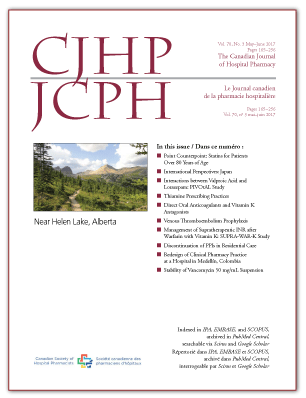Management of Supratherapeutic International Normalized Ratio without Bleeding after Warfarin Use: An Evaluation of Vitamin K Administration (SUPRA-WAR-K Study)
DOI:
https://doi.org/10.4212/cjhp.v70i3.1660Keywords:
anticoagulation, international normalized ratio, phytonadione, vitamin K, warfarin, anticoagulothérapie, rapport international normalisé, vitamine K, warfarineAbstract
ABSTRACT
Background: For patients with supratherapeutic international normalized ratio (INR) and no evidence of bleeding, the 2012 guidelines of the American College of Chest Physicians discourage administration of vitamin K. At the study hospital, it was observed that vitamin K was frequently prescribed for patients with INR of 4.5 or higher and no bleeding.
Objectives: To compare efficacy and safety outcomes between holding warfarin alone and holding warfarin with administration of vitamin K and to compare these outcomes among various doses and routes of vitamin K administration in non–critical care inpatients experiencing supratherapeutic INR without evidence of bleeding.
Methods: This single-centre retrospective chart review involved non–critical care inpatients with supratherapeutic INR (4.5–8.9) without evidence of bleeding. The primary outcomes were the change in INR 1 day after implementation of supratherapeutic INR management and the time to reach INR less than 3.0. The secondary outcomes were length of stay, frequency of warfarin resistance, incidence and duration of bridging anticoagulation, incidence of thromboembolism and major bleeding, and death.
Results: Regardless of vitamin K dose, the administration of vitamin K combined with holding warfarin, relative to holding warfarin alone, was associated with a greater INR decrease 1 day after the intervention (mean ± standard deviation –3.2 ± 1.9 versus –0.9 ± 1.0, p < 0.001) and a shorter time to reach INR below 3.0 (1.9 ± 1.0 days versus 2.6 ± 1.4 days, p = 0.003). No statistically significant differences in any other outcomes were observed.
Conclusions: In hospitalized non–critical care patients with INR between 4.5 and 8.9 without evidence of bleeding, the combination of holding warfarin and administering vitamin K was associated with greater and faster decreases in INR than holding warfarin alone. No significant differences were found in clinically important outcomes. The practice of administering vitamin K in this population warrants further study and re-evaluation.
RÉSUMÉ
Contexte : Dans ses lignes directrices de 2012, l’American College of Chest Physicians déconseille l’administration de vitamine K aux patients ayant des résultats de rapport international normalisé (RIN) suprathérapeutiques et ne présentant aucun saignement. À l’hôpital des auteurs, on a remarqué que l’on prescrivait fréquemment de la vitamine K aux patients répondant aux critères ci-dessus.
Objectifs : Comparer l’efficacité et l’innocuité entre un simple arrêt de la warfarine et l’arrêt de la warfarine combiné à l’administration de vitamine K, puis comparer ces résultats thérapeutiques selon différentes doses et voies d’administration de la vitamine K chez des patients hospitalisés qui ne sont pas en phase critique, qui ont un RIN suprathérapeutique et qui ne présentent aucun saignement.
Méthodes : La présente étude menée dans un seul centre comportait une analyse des dossiers médicaux de patients hospitalisés n’étant pas en phase critique, ayant un RIN suprathérapeutique (4.5–8.9) et ne présentant aucun saignement. Les principaux paramètres d’évaluation étaient le changement du RIN un jour après la mise en oeuvre de mesures pour corriger un RIN suprathérapeutique et le temps nécessaire pour atteindre un RIN de moins de 3,0. Les paramètres d’évaluation secondaires étaient la durée du séjour, la fréquence des cas de résistance à la warfarine, le nombre et la durée des relais anticoagulants, l’incidence des cas de thromboembolie et de saignement important et les cas de décès.
Résultats : L’administration de vitamine K, peu importe la dose, combinée à l’arrêt de la warfarine comparativement au simple arrêt de la warfarine était associée à une réduction plus importante du RIN un jour après l’intervention (moyenne ± écart-type –3.2 ± 1,9 contre –0,9 ± 1,0, p < 0,001) et à un plus court délai pour atteindre un RIN de moins de 3,0 (1,9 ± 1,0 jour contre 2,6 ± 1,4 jours, p = 0.003). Aucune différence statistiquement significative n’a été observée pour le reste des paramètres d’évaluation.
Conclusions : Chez les patients hospitalisés n’étant pas en phase critique, ayant un RIN entre 4,5 et 8,9 et ne présentant aucun saignement, l’arrêt de la warfarine combiné à l’administration de vitamine K a été associé à une réduction plus rapide et plus importante du RIN que le simple arrêt de la warfarine. On n’a observé aucune différence significative en ce qui touche aux résultats thérapeutiques cliniquement importants. L’administration de vitamine K pour cette population est une pratique qui nécessite de plus amples études et doit être évaluée à nouveau.
Downloads
Published
Issue
Section
License
Copyright © Canadian Society of Healthcare-Systems Pharmacy.
After publication of a manuscript in the CJHP, the authors of the manuscript must obtain written permission from the CSHP (publications@cshp.ca) before reproducing any text, figures, tables, or illustrations from the work in future works of their own. If a submitted manuscript is declined for publication in the CJHP, all said rights shall revert to the authors. Please note that any forms (e.g., preprinted orders and patient intake forms) used by a specific hospital or other health care facility and included as illustrative material with a manuscript are exempt from this copyright transfer. The CJHP will require a letter from the hospital or health care facility granting permission to publish the document(s).










